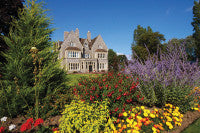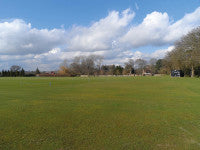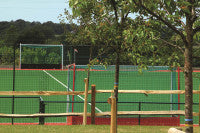Spirit of endeavour at Hurstpierpoint

The reality of old money may seem a world away for many of us but, for Neil Sayers, Grounds Manager of Hurstpierpoint College, the switch forever will be etched in his mind as the day when his salary rocketed.
Neil joined the team in February 1971 on what was "a modest wage", but it was a big step up from his previous employment and catapulted his finances into a different ballpark, he tells me - one that it's perhaps fair to say would not be the case for staff entering the industry today.
Neil began his longstanding career at the College under the tutelage of former head groundsman Reg Harris. "When I arrived here, Reg was due to retire in three years" time and I was set to take over the position after that," explains Neil. "Sadly, Reg passed away within a year of me arriving and I didn't have the experience to take on the role after only a short time in the job."

Although his responsibilities have broadened, Neil, now in his late fifties, is still actively enjoying his role. "I'm planning to spend the rest of my working life at Hurst," he states in typically no-nonsense fashion.
Hurst's team is a small, tight-knit one, with Neil heading up four full-timers, one part-timer and three gardeners (Head Peter Edwards, plus Hayley Hunter and David Hope). Readers will already know Nick Blake, Deputy Head Groundsman, whose sterling voluntary work at Henfield Cricket Club was documented in the April/May issue of Pitchcare. His specialism is maintaining cricket squares, so his know-how comes in particularly handy at Hurst.
Joining Nick are Nigel Swan and Sri Lankan-born 'Mo' Mohammad Samad. The team has weathered various personal storms over the years as some members suffered trials and tribulations with health issues and, for Mo, the threat of deportation back to war-torn Sri Lanka, despite having laid down roots, with a family and young child in Hurstpierpoint.
They all value the support that was given to them by the College, whether it was sticking by its employees through long stretches of illness and keeping jobs open until they returned to full health or, for Mo, making representations to be granted leave to stay in the UK.

I remark on the team's smart workwear. "Yes, Sussex Safety Wear keep us looking pretty," quips Neil. "I'm hot on the importance of us keeping safe and sound on site. We're fully kitted out with all manner of protective equipment, from shoes, boots and wellingtons to sun lotion, and I make sure that we all wear what's necessary."
Neil, unlike many in his position, is perhaps unusual in that, rather than living on site, he instead chose to live locally and forego the sheltered existence that independent schools can offer turfcare professionals. "There are great advantages to being a part of the school community and living on site," Neil says. "But, for me, the idea didn't appeal. I love the job but I also enjoy life outside of Hurst, with my family, so in all my time here I've never once lived in." The chance to break from a work environment arguably makes for more productive staff and the opportunity to step back and reflect upon things, he adds.
Hurstpierpoint College (simply referred to as 'Hurst' and branded accordingly) is my latest delve into the world of the Woodard Group of schools.
Readers may recall Lancing and Ardingly colleges featured in the June/July issue so will, hopefully, have an insight into the prestige and architectural stature of these educational establishments. Hurst is no less formidable. Its chapel may not be quite as imposing as Lancing's, although it is pretty monumental in size nonetheless, and a sense of history hangs all around me, as it does at every Woodard site I have visited.

The school's first headmaster, Rev Edward Clarke Lowe, who had worked with founder Nathanial Woodard at Lancing College, lived in Hurstpierpoint for twenty-two years until his retirement in 1872. The school moved to the Mansion House in the village in 1850 and, thanks to local benefactors the Campion Family, was able to relocate to its present site on 21 June 1853.
The design of Hurst College took inspiration from the collegiate system at Oxford and Cambridge with the layout intended to resemble those cities' powerhouse institutions. Woodard designed the college to have adjoining inner and outer quadrangles with the chapel and dining hall opposite each other.
Today, many of the traditions remain and new pupils carry on the heritage of the school into the 21st century, some of which are fascinating.
The one that always sticks in the memory for all Hurst alumni is the annual, steep walk by the entire senior school's pupils and staff up to the top of 'Danny' - the Hurst name for Wolstonbury Hill, on the South Downs immediately to the south of the College - for the annual Ascension Day service. To this day, the Headmaster still issues 'Lowe's Dole' to the Choir and Sacristans for their work with the spiritual life of the College.
As strongly traditional, although more 'mainstream' is Hurst's sporting heritage, which features as heavily in school life today as it has always done.
The main sports for boys are rugby and hockey in the winter, with cricket and athletics in the summer term, although the appeal of football is growing but currently remains a lower priority. The principal sports for girls are the usual suspects; hockey, netball, athletics and swimming in the summer term. Girls' cricket is also growing in popularity. A wider range of additional sports are on hand for all, with football, tennis and triathlon among the most popular, with mini lacrosse, played by the Prep School boys and girls, recently introduced

Rugby and cricket remain foci of excellence and the conveyer belt of talent rolling off the college's playing fields proves the point. Charlie Matthews represented England at U18 level and is currently playing for Harlequins, with Wales and Biarritz Olympique rugby player Ben Broster and Northampton winger Noah Cato two more recent protégés; Matt Machan (Sussex CCC) and Martin Speight (Sussex, Durham and Northumberland) are just two examples of cricketing alumni.
In Neil's own words, the students are "blessed" with opportunities for sport. No fewer than sixty of the 140 acres making up the estate are devoted to sport and use of the land is increasing steadily as the popularity of minor sports grows and the number of students wanting to participate expands.
The College is rightly proud of its 'sport for all' policy and fields many C, D and even E teams, so that any pupil who wants to play for the College will have the opportunity to do so at some point.

Even with that reduction, the longest square for first team cricket measures in excess of 100m, with a total of thirty wickets prepared by Neil and the team for school use. In addition, the cricketing provision includes a further six grass practice nets and three artificial wickets that are found next to the groundsman's yard.
Summertime sees a frenzy of activity on the squares and Neil runs a host of Ransomes, Allett, Dennis and Ransomes ride-on and pedestrian mowers to handle the expectations - from the sports department and the pupils - for the finest playing surfaces.
The first cricket square was fraise-mowed two seasons back, Neil recalls. "That worked well and it rid the wickets of thatch. We sowed with MM20 Mascot grass dwarf rye, which is doing the trick. "Nicholas is very good with the wicket maintenance."

It's the price of success. "The school is thriving and the sporting use increasing, so the challenge is there to adapt to the conditions and keep the surfaces up to scratch."
The summer 'closed-season' is no less busy for other reasons too, as the grounds are used extensively for training by local and regional sports clubs - and Hurst hosts many matches for the likes of Sussex Martlets and the annual Old Boys Cricket Week, giving Neil and the team little chance of respite.
Tennis is a growing summer sport here. This year, the extension to the netball and tennis facilities will provide eleven tennis hard courts and eight netball courts. The existing area is bordered with an attractive, impeccably-groomed evergreen hedge and Neil will be planting the new area borders with a beech hedge. These act as windbreaks and light barriers to reduce the impact of the new floodlights.

The other sporting zones include Manyweathers, Ruckford, Danworth and Kents Fields, all of which cater for rugby and cricket predominantly, with rounders in the summer for the girls.
Drainage raises its head persistently, given the contours of the grounds, but a sustained programme of work is reducing the likelihood of cancelled matches, Neil says. "Five years ago, we sand-banded Danworth field to 1m centres. All the work has paid off many times over. Rugby and football are played on it all the time - and there's an artificial cricket strip there as well. Along with the other fields that have been drained, we topdress them annually and verti-drain."
Hockey and netball also feature prominently in the school fixture card, but the days of the grass-based game are long gone, as the pattern of decline at many a private and public school (who now opt for the year-round practicality of synthetic) continues.
Students share the use of two synthetic surfaces; a dramatic new full-sized sand-dressed artificial area and a sand-filled artificial pitch, installed over a decade ago, both resplendent a short step away from the historic buildings.

Walking the grounds with Neil, the scale of his remit becomes clear; whether it's keeping on top of the impact of the heavy clay soil, which is being regularly upgraded year on year with extensive drainage improvements; ensuring the first team square is ready for the start of play following a blighted spring preparation or one of his many non-sporting duties, such as tree plantings and forestry management - clearly, his job is never done.
Next door to the synthetics has been planted a most attractive mini orchard of largely prunus trees. Neil consulted with English Landscapes on the scheme, which, along with the recently built car park and games court, with its modern hard landscaping, has replaced the Prep School's former playing field to create a modern, mixed development.

A proposed new groundcare facility, which is in the pipeline, will prove a most welcome addition. Once built, the turfcare team will look every inch a ground force to be reckoned with.
As the autumn and winter schedules loom large, Neil tells me of the importance of efficiency measures to ensure that the team can manage the grounds maintenance challenge. "We try to keep the corners and end crosslines permanently marked out during the summer to help us prepare the pitches for the winter. Every little helps us in our drive to maintain the quality of provision here."
As the end of the cricket season beckoned, Neil's thoughts turned to the renovations - the scarifying, spiking and topdressing, weather permitting. "We have a small window to get everything done. Particularly in summer, keeping all machinery well maintained and up to scratch is critical."
What's in the shed
Ransomes 36in ride-on - used for boxing the cricket square and outfields.
Allett 36in - good workhorse for the cricket squares
Case 75C Quantum tractor - pulls the Verti-drain
Case 3230 tractor - hauls the trailer mower and other attachments
Major mower - for most of the outfields.
Jacobsen Fairway 405 cylinder mower -was traded in for a rotary to cut the football and rugby pitches. With rear rollers on the cutting units, it gives a good finish, with nice striping
Jacobsen D430 Triking 1900D - for the cricket outfields
Ransomes Parkway - cuts the sportsfields and athletics track in summer
Dennis 24in walk-behind wicket mower - gives a fine, quick shave and finish, while the removeable cassettes allow us to add a brush and scarifier when we need to
Ransomes Marquis 61 - first cuts before we shave the wickets
Two Ransomes Super Bowl 51 wicket mowers
SISIS Dart spiker - aerates the cricket squares
Poweroll roller
Tracmaster - the two-wheel tractor we use with flail mower and rotovator.
Leaf blowers, strimmers and brushes
Chemical cabinet - all's as it should be!
John Deere X740 Ultimate - shared with the gardens team. Good collection unit on it
Shibaura compact tractor
Westwood mini tractors x 2
Ernest Doe supply most of the turf machinery
Bourne Amenity are contracted to maintain the synthetic surfaces
